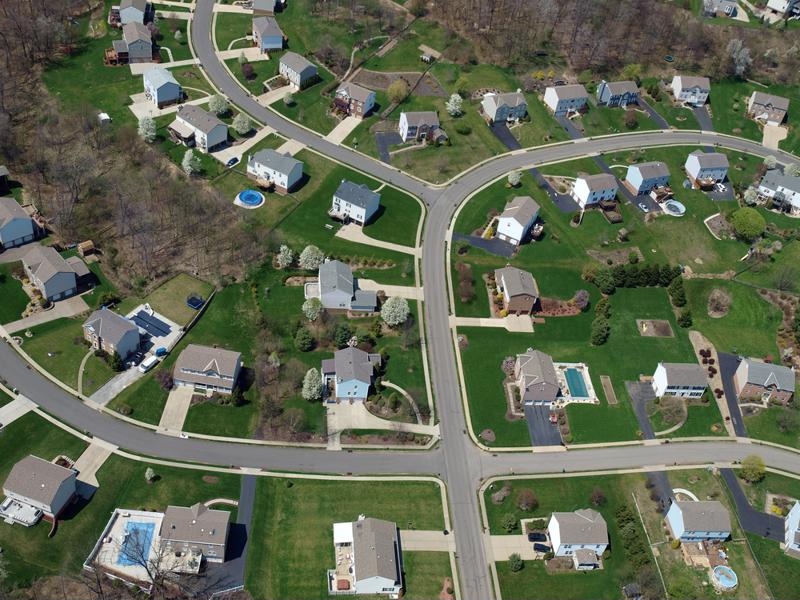If your part of the country got pummeled with several feet or snow and ice this winter, cabin fever probably made you run outdoors the first day temperatures climbed above 40 degrees Fahrenheit. Spring is a time of promise and potential, especially for your lawn that’s been hibernating under a blanket of snow all season.
However, exuberant do-it-yourselfers who want to get back behind the wheel of their state-of-the-art Husqvarna lawn mowers can overdo it if they’re not careful. Taking care of your lawn requires equal parts attention and precision, and if you cut one corner, your yard might suffer all summer. Check out these four common lawn care mistakes you should do everything you can to avoid.
 Don’t let your lawn become the bad one in the neighborhood.
Don’t let your lawn become the bad one in the neighborhood.1. Pro-grass-tination
If you tend a garden along with taking care of your yard, you know that flowers and shrubs grow better if you take care to regularly prune slow-growing branches. While slicing off a part of a plant might seem like the opposite of promoting growth, failing to keep up with a regular mowing schedule can actually harm your lawn’s health.
When you skip a mowing session, you give your grass extra time to grow. While this might seem like a positive, certain patches of grass that receive more nutrients or sunlight can grow longer and faster than others – if you let your lawn grow too long, tall blades can steal light and food from younger shoots just starting to grow. Continual germination is critical for a healthy lawn, but skipping a mowing session may put that in doubt.
2. Onto the trash heap
One of the most perplexing aspects of mowing your lawn is figuring out what you’re going to do with the excess clippings. If you’re unlucky enough to be stuck with an old-fashioned manual mower or a cheap model that just spews clippings back onto your lawn, you might be setting your lawn up for failure. On the other side of the equation, though, throwing your clippings away could be just as much of a waste.
Instead, you should collect your clippings, mulch them and spread them around your lawn as a natural fertilizer. Fresh-cut grass is often rich in nitrogen, an element critical to your lawn’s health, and mulching what you cut not only saves you money on fertilizer, but it’s also safer for the environment.
“Mulching your clippings requires equipment capable of handling the job.”
Mulching your clippings requires equipment capable of handling the job, though, and you’ll want to go with mowers like the Husqvarna HU550FH Walk Behind Mower. This model comes with a 2.2-cubic foot clippings collection bag, so with a bit of extra effort, you could have enough grass mulch to naturally fertilize your entire yard and then some.
3. Settling for less than the best
It’s no secret that DIY lawn care is a massive industry, and that means you have a wide breadth of options available to you when you’re looking for the tools and equipment that are best for your lawn and your budget. However, having so many options also means that not all of them are going to be worth your time or money.
Buying cheap lawn care equipment might seem like it’ll save you money, but that’s only in the short term. Mowers, leaf blowers and other tools with higher price tags often come with more features, like self-propulsion and easy bag removal, but the thing you really need to be concerned about is the quality of the engine. Cheap models might run well at first, but take them through a thick patch of grass or run them hard for a few months and they’ll show their low quality pretty quickly. Go with industry-trusted models from Husqvarna to avoid headaches you don’t need.
4. Roots in wrong soil
Head to your local yard care superstore and ask about which kind of flowers would grow best in your region. Odds are they’ll have dozens of answers for you, but if you ask the same question about which kind of grass you should have in your lawn, you might get a blank stare in return.
In fact, many homeowners might not even know what species of grass comprises their lawns, and this can lead to undue complications. For example, Kentucky bluegrass can’t grow in partial shade – even though you spend all day and night tending to your lawn, those towering trees on your property make it so that particular strain just isn’t suited for your property. Resodding can be a time-consuming and expensive project, but if you really care about the look of your yard, it’s less expensive than toiling away for years with expensive equipment and materials.